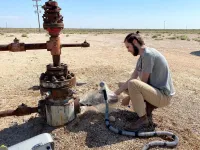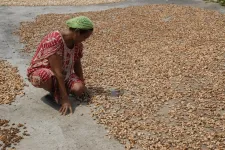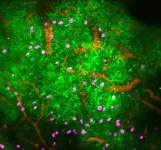How a SARS-CoV-2 variant sacrifices tight binding for antibody evasion
2021-04-28
(Press-News.org) The highly infectious SARS-CoV-2 variant that recently emerged in South Africa, known as B.1.351, has scientists wondering how existing COVID-19 vaccines and therapies can be improved to ensure strong protection. Now, researchers reporting in ACS' Journal of Medicinal Chemistry have used computer modeling to reveal that one of the three mutations that make variant B.1.351 different from the original SARS-CoV-2 reduces the virus' binding to human cells -- but potentially allows it to escape some antibodies.
Since the original SARS-CoV-2 was first detected in late 2019, several new variants have emerged, including ones from the U.K., South Africa and Brazil. Because the new variants appear to be more highly transmissible, and thus spread rapidly, many people are worried that they could undermine current vaccines, antibody therapies or natural immunity. Variant B.1.351 bears two mutations (N501Y and E484K) that can enhance binding between the receptor binding domain (RBD) of the coronavirus spike protein and the human ACE2 receptor. However, the third mutation (K417N; a lysine to asparagine mutation at position 417) is puzzling because it eradicates a favorable interaction between the RBD and ACE2. Therefore, Binquan Luan and Tien Huynh from IBM Research wanted to investigate potential benefits of the K417N mutation that could have caused the coronavirus to evolve along this path.
The researchers used molecular dynamics simulations to analyze the consequences of the K417N mutation in variant B.1.351. First, they modeled binding between the original SARS-CoV-2 RBD and ACE2, and between the RBD and CB6, which is a SARS-CoV-2-neutralizing antibody isolated from a recovered COVID-19 patient. They found that the original amino acid, a lysine, at position 417 in the RBD interacted more strongly with CB6 than with ACE2, consistent with the antibody's therapeutic efficacy in animal models. Then, the team modeled binding with the K417N variant, which changes that lysine to an asparagine. Although this mutation reduced the strength of binding between the RBD and ACE2, it decreased the RBD's binding to CB6 and several other human antibodies to a much greater extent. Thus, variant B.1.351 appears to have sacrificed tight binding to ACE2 at this site for the ability to evade the immune system. This information could prove useful to scientists as they work to enhance the protection of current vaccines and therapies, the researchers say.
INFORMATION:
The authors acknowledge funding from their employer, IBM.
The abstract that accompanies this paper is available here.
The American Chemical Society (ACS) is a nonprofit organization chartered by the U.S. Congress. ACS' mission is to advance the broader chemistry enterprise and its practitioners for the benefit of Earth and all its people. The Society is a global leader in promoting excellence in science education and providing access to chemistry-related information and research through its multiple research solutions, peer-reviewed journals, scientific conferences, eBooks and weekly news periodical Chemical & Engineering News. ACS journals are among the most cited, most trusted and most read within the scientific literature; however, ACS itself does not conduct chemical research. As a leader in scientific information solutions, its CAS division partners with global innovators to accelerate breakthroughs by curating, connecting and analyzing the world's scientific knowledge. ACS' main offices are in Washington, D.C., and Columbus, Ohio.
To automatically receive news releases from the American Chemical Society, contact newsroom@acs.org.
Follow us: Twitter | Facebook
ELSE PRESS RELEASES FROM THIS DATE:
2021-04-28
Uncapped, idle oil wells could be leaking millions of kilograms of methane each year into the atmosphere and surface water, according to a study by the University of Cincinnati.
Amy Townsend-Small, an associate professor of geology and geography in UC's College of Arts and Sciences, studied 37 wells on private property in the Permian Basin of Texas, the largest oil production region on Earth. She found that seven had methane emissions of as much as 132 grams per hour. The average rate was 6.2 grams per hour.
"Some of them were leaking a lot. Most of them were leaking a little or not at all, which is a ...
2021-04-28
April 28, 2021 -- Using naturalistic driving data and machine learning techniques, researchers at Columbia University Mailman School of Public Health and Columbia's Fu Foundation School of Engineering and Applied Science have developed highly accurate algorithms for detecting mild cognitive impairment and dementia in older drivers. Naturalistic driving data refer to data captured through in-vehicle recording devices or other technologies in the real-world setting. These data could be processed to measure driving exposure, space and performance in great detail. The findings are published in the journal Geriatrics.
The researchers developed random forests models, a statistical technique ...
2021-04-28
People of color, those with a higher income and younger individuals are more likely to participate in clinical trials during their cancer treatment according to a new study from the University of Missouri School of Medicine.
Clinical trials are research studies that involve people who volunteer to take part in tests of new drugs, current approved drugs for a new purpose or medical devices.
The study analyzed data collected from the Centers for Disease Control and Prevention (CDC) Behavioral Risk Factor Surveillance System Survey, which is an annual national telephone survey designed to collect health-related data from U.S. adults. Survey years selected included the question, "Did you participate in a clinical trial ...
2021-04-28
Chocolate is a beloved treat, but sometimes the cocoa beans that go into bars and other sweets have unpleasant flavors or scents, making the final products taste bad. Surprisingly, only a few compounds associated with these stinky odors are known. Now, researchers reporting in ACS' Journal of Agricultural and Food Chemistry have identified the two compounds that cause musty, moldy scents in cocoa -- work that can help chocolatiers ensure the quality of their products.
Cocoa beans, when fermented correctly, have a pleasant smell with sweet and floral notes. But they can have an off-putting scent when fermentation goes wrong, or when storage conditions ...
2021-04-28
When seasonal rains arrive late in Indonesia, farmers often take it as a sign that it is not worth investing in fertilizer for their crops. Sometimes they opt out of planting annual crops altogether. Generally, they're making the right decision, as a late start to the rainy season is usually associated with the state of El Niño Southern Oscillation (ENSO) and low rainfall in the coming months.
New research published in the Nature journal Scientific Reports shows that ENSO, the weather-shaping cycle of warming and cooling of the Pacific Ocean along the Equator, is a strong predictor of cacao harvests up to two years before a harvest.
This is potentially ...
2021-04-28
CHAMPAIGN, Ill. -- A higher ratio of green spaces at the county level is associated with a lower racial disparity in coronavirus infection rates, according to a new study. It is the first study to report the significant relationship between the supply of green spaces and reduced disparity in infectious disease rates.
The research team included William Sullivan, a landscape architecture professor at the University of Illinois Urbana-Champaign, and was led by Bin Jiang, a landscape architecture professor at The University of Hong Kong who received his Ph.D. at Illinois, and Yi Lu, an architecture professor at City University of Hong Kong. They reported their findings in the journal Environment ...
2021-04-28
UNIVERSITY PARK, Pa. -- There are hard-to-please customers in almost every industry, with certain people being picky about which clothes, houses and even romantic partners they will consider.
A new series of studies has found that shopper pickiness can go beyond shopping for the "best" option. The researchers define what it means to be "picky" and also developed a scale for measuring shopper pickiness.
Margaret Meloy, department chair and professor of marketing at Penn State, said the findings could help companies devise the best strategies for satisfying their pickier customers.
"If a company knows they have a lot of picky customers, they may need to change the way they reward salespeople or dedicate specific salespeople to their pickiest customers, because ...
2021-04-28
In collaboration with VGP, the research group has published a research paper in Nature on platypus and echidna genomes early this year (see report in the right column). In the Nature current special issue, the research group published another study on the genome of the common marmoset, an important primate model for neurodegenerative diseases, drug development and other biomedical research.
The genome includes two sets of chromosomes, one inherited from the mother, the other from the father. In traditional genome sequencing efforts including the human genome project, the sequencing only produced a mosaic reference ...
2021-04-28
While evolution is normally thought of as occurring over millions of years, researchers at the University of California, Irvine have discovered that bacteria can evolve in response to climate change in 18 months. In a study published in the Proceedings of the National Academy of Sciences, biologists from UCI found that evolution is one way that soil microbes might deal with global warming.
Soil microbiomes - the collection of bacteria and other microbes in soil - are a critical engine of the global carbon cycle; microbes decompose the dead plant material to recycle nutrients back into the ecosystem and release carbon back into the atmosphere. Multiple environmental factors influence the composition and functioning of soil microbiomes, ...
2021-04-28
The neurotransmitter noradrenaline, which plays a key role in the fight-or-flight stress response, impairs immune responses by inhibiting the movements of various white blood cells in different tissues, researchers report April 28th in the journal Immunity. The fast and transient effect occurred in mice with infections and cancer, but for now, it's unclear whether the findings generalize to humans with various health conditions.
"We found that stress can cause immune cells to stop moving and prevents immune cells from protecting against disease," says senior study author University of Melbourne's Scott Mueller (@SMuellerLab) of the Peter Doherty Institute for Infection and Immunity (Doherty Institute). "This is novel because it was not known that ...
LAST 30 PRESS RELEASES:
[Press-News.org] How a SARS-CoV-2 variant sacrifices tight binding for antibody evasion



